|
|
|
Sort Order |
|
|
|
Items / Page
|
|
|
|
|
|
|
| Srl | Item |
| 1 |
ID:
154196
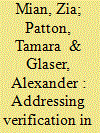

|
|
|
|
|
| Summary/Abstract |
The UN General Assembly last December called for negotiations this year to produce a "legally binding instrument to prohibit nuclear weapons, leading to their total elimination." The nuclear ban treaty talks will have to engage the issue of confirming compliance by the parties with the specific prohibitions established by such a treaty and, in addition, can establish guiding principles for the process of eliminating nuclear weapons and maintaining the resulting nuclear-weapon-free world.
|
|
|
|
|
|
|
|
|
|
|
|
|
|
|
|
| 2 |
ID:
132781
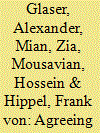

|
|
|
|
|
| Publication |
2014.
|
| Summary/Abstract |
Iran is negotiating with a group of six states over the future of its nuclear program. In November 2013, Iran and the P5+1 (China, France, Germany, Russia, the United Kingdom, and the United States) agreed to a Joint Plan of Action that seeks to reach a "comprehensive solution" by July 20, 2014.
The goal is an agreement on a set of measures that can provide reasonable assurance that Iran's nuclear program will be used only for peaceful purposes and enable the lifting of international sanctions imposed on Iran over the past decade because of proliferation concerns.
A key challenge is to reach agreement on limiting Iran's uranium-enrichment program, which is based on gas centrifuges, in a way that would enable Iran to meet what it sees as its future needs for low-enriched uranium (LEU) fuel for nuclear research and power reactors while forestalling the possibility that this program could be adapted to quickly produce highly enriched uranium at levels and in amounts suitable for use in nuclear weapons
|
|
|
|
|
|
|
|
|
|
|
|
|
|
|
|
| 3 |
ID:
134047
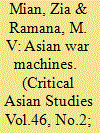

|
|
|
|
|
| Publication |
2014.
|
| Summary/Abstract |
The South Asian security landscape is increasingly dominated by a complex four-way dynamic between India, Pakistan, China, and the United States. The stresses and strains of the relationships between these states directly affect the prospects for peace and prosperity for almost half of humanity. This article describes some of the military contours of this landscape, with a focus on strategic postures, weapon acquisitions, and the role of nuclear weapons. It maps the India-Pakistan arms race over the past decade, the economic constraints on the two states, the role of China and the United States as weapons suppliers, and the risk and consequences for nuclear war. The authors then look at India's relationship with China, which is marked by both cooperation and competition, and the rise of China as a close military, political, and economic ally of Pakistan. While the United States has had long-standing cooperative relationships with both India and Pakistan, these relationships have been undergoing major shifts over the last two decades. U.S. concerns about China's increasing military and economic power have also intensified over this period as well. Of particular significance has been the effort to create a U.S.-India strategic partnership to balance and contain a rising China, which may become a central feature of the emerging global order. This article also offers a brief overview of what is publicly known about the nuclear arsenals of the four countries, ongoing production of weapons-usable fissile materials in Pakistan and India, as well as the race to build longer-range missiles.
|
|
|
|
|
|
|
|
|
|
|
|
|
|
|
|
| 4 |
ID:
053602


|
|
|
|
|
| Publication |
Oxford, Oxford University Press, 2004.
|
| Description |
xxxviii, 329p.
|
| Standard Number |
0195798058
|
|
|
|
|
|
|
|
|
|
|
|
Copies: C:1/I:0,R:0,Q:0
Circulation
| Accession# | Call# | Current Location | Status | Policy | Location |
| 048608 | 327.5491054/AHM 048608 | Main | On Shelf | General | |
|
|
|
|
| 5 |
ID:
099718
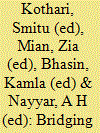

|
|
|
|
|
| Publication |
New Delhi, Orient Blackswan, 2010.
|
| Description |
347p.
|
| Standard Number |
9788125038306
|
|
|
|
|
|
|
|
|
|
|
|
Copies: C:1/I:0,R:0,Q:0
Circulation
| Accession# | Call# | Current Location | Status | Policy | Location |
| 055378 | 327.54005491/KOT 055378 | Main | On Shelf | General | |
|
|
|
|
| 6 |
ID:
127633
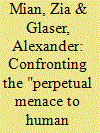

|
|
|
|
|
| Publication |
2014.
|
| Summary/Abstract |
Nuclear weapon states historically have attached great secrecy to their nuclear weapon and fissile material production programs and stockpiles, despite warnings that this would fuel fears, handicap informed debate and decision making, and drive arms races. As evidenced by the "Action Plan on Nuclear Disarmament" agreed upon at the 2010 Treaty on the Non-Proliferation of Nuclear Weapons (NPT) Review Conference, however, the international community now sees greater transparency about nuclear weapon and fissile material stocks as necessary for enabling and monitoring progress toward nuclear disarmament. To support this effort, the International Panel on Fissile Materials has proposed a step-by-step program for weapon states to declare their inventories, production histories, and disposition of nuclear warheads and fissile materials, and to set up joint projects to develop methods for verifying these declarations. This openness initiative is described here, and could be adopted at the 2015 NPT Review Conference, laying a basis for negotiating verifiable deep reductions in nuclear arsenals and their eventual elimination.
|
|
|
|
|
|
|
|
|
|
|
|
|
|
|
|
| 7 |
ID:
092913
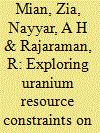

|
|
|
|
|
| Publication |
2009.
|
| Summary/Abstract |
This paper evaluates possible scenarios for Pakistan's uranium enrichment and plutonium production programs since the late 1970s by using Pakistan's supply of natural uranium as a constraint. Since international sanctions have prevented Pakistan from importing uranium for decades, it has had to rely on domestic uranium production-currently estimated as approximately 40 tons a year. The paper divides the development of Pakistan's uranium enrichment and plutonium production programs into three broad periods: from the beginning in the late 1970s until the 1998 nuclear tests; from 1999 to the present; and from the present to 2020; and considers how Pakistan could allocate its domestic uranium between its uranium enrichment and plutonium production programs for each period. This assessment is completed for enrichment capacities ranging from 15,000 to 75,000 separative work units (SWU) and takes into account the construction of the second and third plutonium production reactors at Khushab. The study finds that Pakistan may have sufficient natural uranium to fuel the three reactors, if they are approximately 50 MWt each, but that for some of these enrichment capacities, there will be a shortfall of natural uranium by 2020. The paper considers the impact of alternative sources of enrichment feed such as depleted tails from previous enrichment activity and reprocessed uranium from low-burn-up spent fuel from the Khushab reactors. There are signs Pakistan early on may have enriched some reprocessed uranium, possibly acquired from China. It finds that by 2020, Pakistan could have accumulated approximately 450 kg of plutonium from the Khushab reactors and 2500-6000 kg of highly enriched uranium (HEU) (90 percent enriched) for enrichment capacities ranging from 15,000-75,000 SWU. These stocks would be sufficient for perhaps 100-240 simple fission weapons based on HEU and for 90 plutonium weapons. Pakistan may be able to produce more weapons if it either increases its rate of uranium mining or has more advanced weapon designs requiring less fissile material in each weapon.
|
|
|
|
|
|
|
|
|
|
|
|
|
|
|
|
| 8 |
ID:
085059
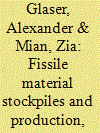

|
|
|
|
|
| Publication |
2008.
|
| Summary/Abstract |
This article presents estimates of global and national stockpiles of highly enriched uranium and separated plutonium based on the 2008 Global Fissile Material Report by the International Panel on Fissile Materials.1 The global stockpile of highly enriched uranium (HEU) is estimated to be 1670 ± 300 tons. It is declining as Russia and the United States blend down about 40 tons per year of HEU for use in light-water power-reactor fuel. This rate of blend-down is far higher than the estimated rate of production of HEU, currently believed to be limited to production by Pakistan for weapons and by India for naval fuel. The global stockpile of separated plutonium, all of which can be used for weapons, is about 500 tons. About half of this stockpile is civilian and is currently growing at less than 5 tons a year. This rate will increase significantly once Japan's Rokkasho reprocessing plant begins commercial operation. Only India and Pakistan and perhaps Israel are believed to be producing plutonium for weapons, at a combined rate of less than 60 kg per year. The United States and Russia have declared as excess to weapons requirements or for all military purposes a significant fraction of their stocks of both highly enriched uranium and plutonium produced for weapons. The United States and Russia continue to blend down the 210 and 500 tons, respectively, of HEU that they have declared excess to produce low-enriched uranium to fuel light-water reactors. The United States and Russia have yet to put in place the infrastructure to eliminate the 34 tons of excess weapons plutonium each committed to dispose under the 2000 U.S.-Russian Plutonium Management and Disposition Agreement. The past two years have also seen plans for new civilian enrichment plants and progress on new reprocessing plants. During this time, some former production facilities have been shut down, others dismantled, and in some cases key components have been demolished.
|
|
|
|
|
|
|
|
|
|
|
|
|
|
|
|
| 9 |
ID:
075373
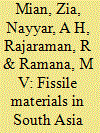

|
|
|
|
|
| Publication |
2006.
|
| Summary/Abstract |
The July 2005 U.S.-India joint statement represents a fundamental transformation of U.S.-India relations and at the same time a challenge to the disarmament and non-proliferation regimes. There is concern that the March 2006 separation plan proposed by India for demarcating its military and civilian nuclear facilities may allow a potentially rapid expansion of its capacity for fissile material production for weapons. In this analysis, we have assessed fissile material production capabilities in India and how they might change as a result of the U.S.-India deal. We look at current stockpiles of fissile materials in India and Pakistan and estimate the changing capacity for future fissile material production as India progressively places some of its heavy water reactors under safeguards. We assess India's uranium resource constraints and the additional weapons grade plutonium production in its unsafeguarded heavy water power reactors that would be made possible by imports of uranium allowed by the deal. We also estimate the weapons plutonium production from India's fast breeder reactor that is under construction and is to be unsafeguarded.
|
|
|
|
|
|
|
|
|
|
|
|
|
|
|
|
| 10 |
ID:
134488
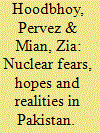

|
|
|
|
|
| Summary/Abstract |
In the four decades since Pakistan launched its nuclear weapons program, and especially in the fifteen years since the nuclear tests of 1998, a way of thinking and a related set of feelings about the bomb have taken hold among policy-makers and the public in Pakistan. These include the ideas that the bomb can ensure Pakistan's security; resolve the long-standing dispute with India over Kashmir in Pakistan's favour; help create a new national spirit; establish Pakistan as a leader among Islamic countries; and usher in a new stage in Pakistan's economic development. None of these hopes has come to pass, and in many ways Pakistan is much worse off than before it went nuclear. Yet the feelings about the bomb remain strong and it is these feelings that will have to be examined critically and be set aside if Pakistan is to move towards nuclear restraint and nuclear disarmament. This will require a measure of stability in a country beset by multiple insurgencies, the emergence of a peace movement able to launch a national debate on foreign policy and nuclear weapons, and greater international concern regarding the outcomes of nuclear arms racing in South Asia.
|
|
|
|
|
|
|
|
|
|
|
|
|
|
|
|
| 11 |
ID:
180431
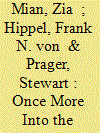

|
|
|
|
|
| Summary/Abstract |
In Princeton 75 years ago, Albert Einstein announced the formation of the Emergency Committee of Atomic Scientists to educate and mobilize other scientists and the public on the dangers to humanity of the nuclear weapons recently developed by the United States and used to destroy two Japanese cities. The committee of distinguished scientists, almost all of whom had been part of the nuclear weapons program, declared, “We scientists recognize our inescapable responsibility to carry to our fellow citizens an understanding of the simple facts of atomic energy and its implications for society. In this lies our only security and our only hope. We believe that an informed citizenry will act for life and not for death.
|
|
|
|
|
|
|
|
|
|
|
|
|
|
|
|
| 12 |
ID:
046557
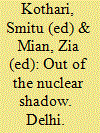

|
|
|
|
|
| Publication |
DelhI, Lokmanya, 2001.
|
| Description |
525p.
|
| Standard Number |
1842770586
|
|
|
|
|
|
|
|
|
|
|
|
Copies: C:1/I:0,R:0,Q:0
Circulation
| Accession# | Call# | Current Location | Status | Policy | Location |
| 045457 | 355.825119/KOT 045457 | Main | On Shelf | General | |
|
|
|
|
| 13 |
ID:
095269
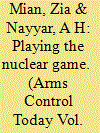

|
|
|
|
|
| Publication |
2010.
|
| Summary/Abstract |
Since May 2009, Pakistan, largely alone, has blocked the start of international talks on a fissile material cutoff treaty (FMCT) at the 65-member Conference on Disarmament (CD) in Geneva.[1] The treaty would ban the production of fissile materials for weapons purposes; fissile materials, namely plutonium and highly enriched uranium (HEU), are the key ingredients in nuclear weapons. Pakistan has prevented these negotiations despite having accepted last year a CD program of work that included an FMCT.
|
|
|
|
|
|
|
|
|
|
|
|
|
|
|
|
| 14 |
ID:
073471
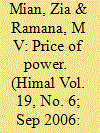

|
|
|
| 15 |
ID:
152056
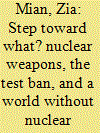

|
|
|
|
|
| Summary/Abstract |
Historically, nuclear-explosive testing was not required to develop simple, reliable, gun-type nuclear weapons with highly enriched uranium as the chain-reacting material. Testing may now not be required to build basic implosion weapons using plutonium. This suggests that, even if no state had ever conducted a nuclear test, a nuclear-armed world could still have emerged, but probably without thermonuclear weapons. The examples of the United States, Russia, the United Kingdom, France, and Pakistan suggest that, despite the twenty-year-old Comprehensive Nuclear-Test-Ban Treaty (CTBT), nuclear-weapon states with very different testing legacies expect to continue developing, and in some cases deploying, new nuclear weapons. The entry into force of the CTBT might not significantly constrain nuclear-weapons development for any state, and a worthwhile goal now may be to focus on other agreements to restrict nuclear weapon activities, in particular an agreement to ban nuclear weapons.
|
|
|
|
|
|
|
|
|
|
|
|
|
|
|
|
| 16 |
ID:
130326
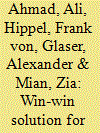

|
|
|
|
|
| Publication |
2014.
|
| Summary/Abstract |
In November 2013, Iran and the P5+1 group of countries (China, France, Germany, Russia, the United Kingdom, and the United States) agreed on a six-month Joint Plan of Action to enable negotiations on a final settlement to contain the proliferation risks from Iran's nuclear program. This interim agreement freezes Iran's enrichment capacity, thereby preventing a further shortening of the time Iran would require to produce weapons quantities of highly enriched uranium (HEU) if it wished.1 This enrichment capacity has expanded greatly over the years since it first came to international attention in 2002. Iran and the P5+1 also have agreed on the need to constrain Iran's option to produce plutonium for weapons using the reactor that is under construction near the city of Arak and that will be under International Atomic Energy Agency (IAEA) safeguards. Under the Joint Plan of Action, Iran has agreed to freeze the Arak reactor project for six months.2 It also has committed not to separate plutonium from spent nuclear fuel or construct a facility capable of doing so. These are important interim commitments. According to Ali Akbar Salehi, the head of the Atomic Energy Organization of Iran, the Arak reactor is intended for radioisotope production and testing of nuclear fuel and materials. In response to the P5+1 proposal that Iran scrap the Arak reactor project, Salehi stated that "we see no point stopping the work on this reactor." He has acknowledged, however, the international community's concerns about the Arak reactor and offered the possibility of design changes "in order to produce less plutonium in this reactor and in this way allay the worries and mitigate the concerns.
|
|
|
|
|
|
|
|
|
|
|
|
|
|
|
|
| 17 |
ID:
067764


|
|
|
|
|
|
|
|